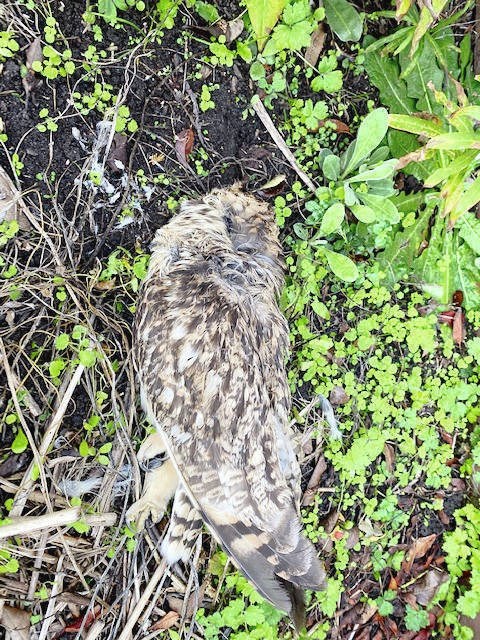At least seven owls discovered dead over the past year in Greater Victoria are believed to have been killed by eating poisoned rats.
An owl advocacy group fears it’s only the tip of the iceberg when it comes to deaths resulting from use of powerful anticoagulant rodenticides, many of which are easily purchased at hardware stores.
“These are only the owls that have been found and reported … who knows how many more have died and what else [poisons] have killed?” said Deanna Pfeifer of Owl Watch.
The latest fatality was a short-eared owl, rarely seen in the area and likely on a migration path, found dead and intact in the garden of a home bordering Lansdowne Middle School in Saanich.
Three other dead owls have been found in Saanich, another pair was discovered in the Uplands neighbourhood and an owl death was reported in Oak Bay this year. About half have been sent for necropsies at a provincial wildlife facility in Nanaimo.
One of the victims was a great-horned owl that lived in Cuthbert Holmes Park in Saanich for nearly a decade and was known as Ollie to nearby residents.
Pfeifer said it’s ironic that owls, which can eat up to 1,000 rats and mice in a year, are being killed by poisons that humans put into their main food source.
She isn’t the only one outraged. Saanich Mayor Fred Hayes is leading a group of local mayors and councils that are planning to pressure the provincial government for an outright ban on the use of rodenticides, saying the poisons are not only killing owls, crows and other animals, but pose a danger to pets and urban ecosystems.
Saanich, along with View Royal, Sooke, Oak Bay, Victoria, Colwood and North Saanich, have recently banned the use of rodenticides on all municipal properties, including buildings, parks and maintenance yards. Pfeifer said other municipalities up Island and across B.C. are also preparing motions for bans.
The municipal bans, however, don’t apply to private and commercial properties, or restrict pest-control companies.
Until the election results are finalized, the Environment Ministry said it can’t provide comment.
An inquiry to a provincial wildlife veterinarian about the owl deaths was re-routed to federal officials, who did not return a call by press time.
Haynes said he is troubled by evidence that toxic rodenticides are showing up in the carcasses of owls, despite pest professionals telling him that rats tend to stay in their burrows and other hiding places after ingesting poisons. “Clearly, that’s not happening,” he said.
Haynes noted that poisoned rodents sometimes takes months to die from internal bleeding. He said evidence also shows poisons slow their movements, making them easy prey for raptors and crows, even pets.
Chris Day, president of the Structured Pest Management Association of B.C., told the Times Colonist last month that pest-control companies work closely with the province and under federal guidelines for the safe use of rodenticides.
Day, Vancouver Island branch manager for Orkin Canada, said qualified pest-control technicians use secure bait traps and dispose of dead rodents in a responsible way to lessen the risk of secondary poisonings.
Prior to the provincial election call, Environment Minister George Heyman had told Haynes the province was not willing to ban rodenticides, but will increase education about the issue.
Undeterred, Haynes plans to continue fighting for a ban, aligning like-minded mayors and councils so the issue can be at the “top of the queue” when a new Environment Minister is named next month.
“To protect our biodiversity, we have to stand up,” said Hayes. “These rodenticides have a much larger kill zone than just rodents. It not only goes to our precious wildlife, but into our pets and into the food stream.”
In a presentation to Sooke council last month, Marie Turcot, a law student who produced a report on the legal framework for pesticide regulation in Canada, said her research showed anti-coagulant rodenticides are having a wide effect on native and at-risk species.
In addition to rats, small animals including songbirds, shrews, voles, and other mammals and invertebrates are known to access bait boxes containing anticoagulant rodenticides, Turcott said.
“This direct feeding is contaminating the food-chain and wider ecosystem,” she said, noting birds of prey, snakes, coyotes, raccoons, bobcats, foxes, skunks and other mammalian predators that feed on small animals have been found to have traces of rodenticides in their systems.
She said rodenticides can also enter the soil via decomposing carcasses, and poisons have even been found in the aquatic food web.
The report said 70% of dead owls from B.C. between 1988 and 2003 had residues of at least one rat poison — and numbers are increasing.
The BCSPCA agrees with the ban, calling poisons an inhumane and ineffective way of controlling rodents.
Proponents of the ban say the best way to control rodents is taking away food sources and habitat.
Haynes, who has had rat problems at his own home, said residents should plug holes in their foundations and roof eaves, keep garbage and recycling covered and secured and use snap traps that quickly kill.
“The irony is [poisons] are ineffective in reducing rat populations … the numbers are still there,” Haynes said. “They give people a false sense of security. We can only control rats by controlling habitats and food sources.”
dkloster@timescolonist.com



